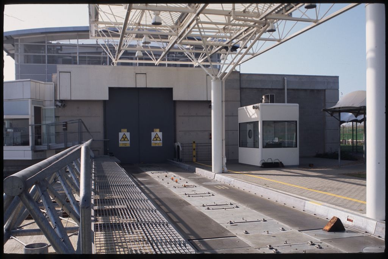pdf Inadvertent exposure to persons in vehicle x-ray facility (1.39 MB)
Description of the incident
A high voltage (5000 kV) security X-ray facility is used for detecting explosives in freight vehicles. The vehicles pass through the facility on flat bed railcars and warning signs instruct the driver that all persons must alight from the vehicle before it enters the facility. This incident occurred when, after several reported faults with the radiation monitor in the radiography tunnel, two engineers went into investigate. The ‘search and lock-up’ routine was disabled via the software to minimise down time for the investigation and the facility put in maintenance mode. When the two engineers entered the tunnel, the flashing exposure indication light within the tunnel was not illuminated. When they approached the installed radiation monitor, located adjacent to the narrowly collimated X-ray source, they realised it was switched off. After going through its initialisation procedure, the monitor then sounded the alarm suggesting that the dose rate threshold on the monitor (about 3 μSv/h) had been exceeded. The engineers immediately left the tunnel. On returning to the control screen, the display indicated that the shutter was closed and the radiation generator was off.
The incident was immediately reported to the Radiation Protection Supervisor and subsequently the Radiation Protection Adviser. The dose investigation revealed a number of uncertainties; it is not known whether the generator was on or if the shutter was open or closed at the time the engineers were in the tunnel. The energy of the X-rays is unknown, as is the current. The exact movements within the tunnel of the engineers are also unknown.
Further investigations revealed that it is possible to open the tunnel entry doors, switch off the tunnel installed radiation monitor, and start the radiation generator with the shutter open. However, on each occasion the flashing exposure warning light indicated an exposure was taking place.

Radiological Consequences
One of the engineers was wearing a personal dosemeter. This indicated zero dose. Results from blood sample tests from both engineers indicated that neither had been overexposed to penetrating ionising radiations.
A worst case reconstruction indicated that whole body doses of 1.2 mSv and partial body (assumed skin) doses of 30 mSv could have been received by the engineers.
Lessons learned
Although fixed radiation monitors and safety systems should warn against entry into areas of high radiation dose rates, a hand-held monitor and/or personal alarm dosemeter can often be a vital part of radiation safety procedures.
It should be regularly ensured that ALL relevant persons are fully conversant with the procedures and requirements of the local rules. This is particularly important when staff changes occur.
Local rules must be reviewed and audited at regular intervals. In particular, where it is feasible that persons may be exposed to significant doses of radiation, contingency plans must give full details of all actions to be taken.
pdf Inadvertent exposure to persons in vehicle x-ray facility (1.39 MB)



